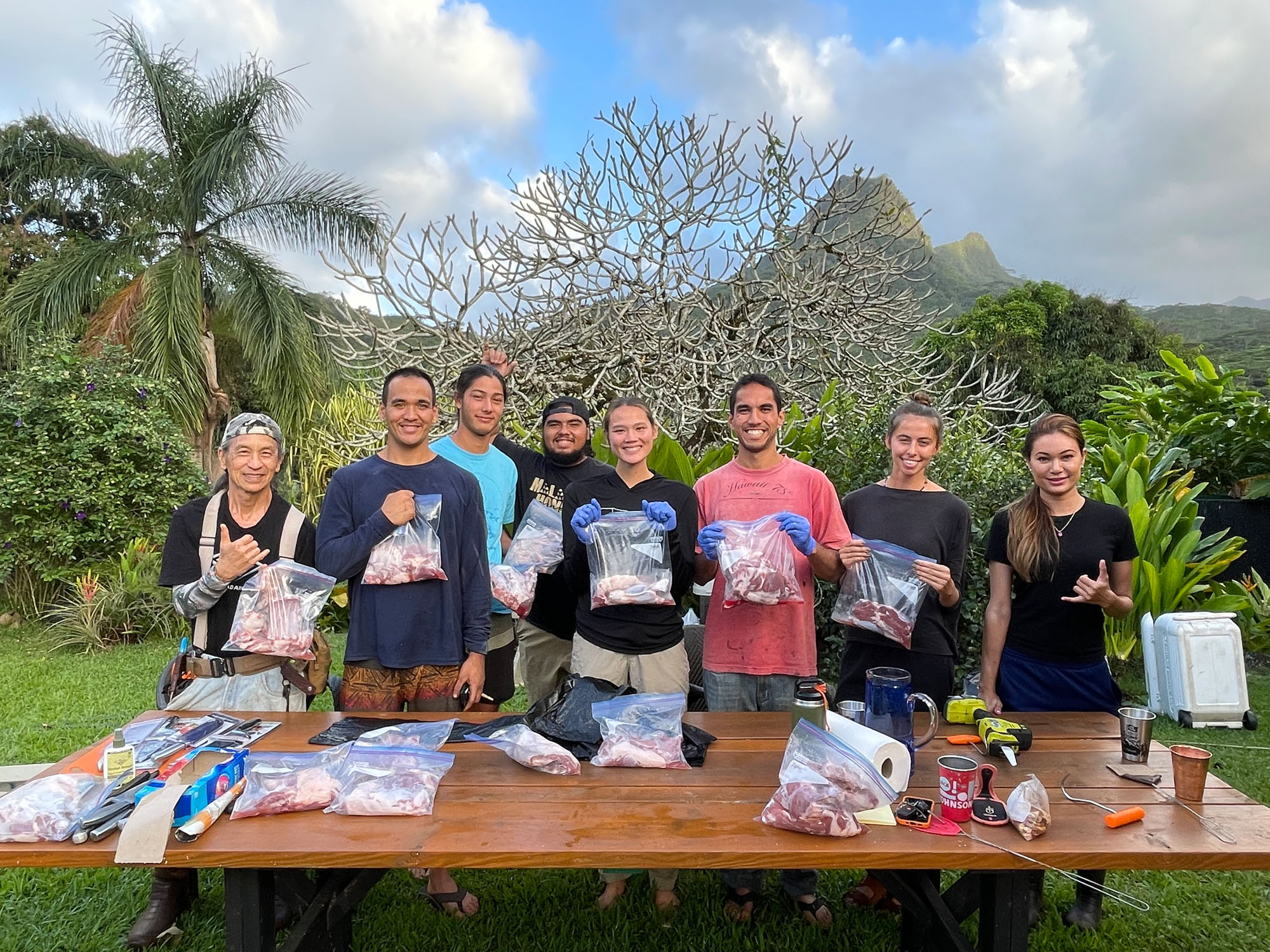Safe to Eat?
They’re everywhere! On Oʻahu and on all the other islands, large feral pigs are roaming the public and private lands, rural and urban. They’re incredibly destructive—and they’re nutritious and delicious. According to the USDA, they are also known to carry, “at least 30 viral and bacterial diseases and nearly 40 parasites that can be transmitted to humans, pets, livestock, and other wildlife.”
Are they safe to eat? Perhaps you’ve been invited to a neighbor’s pig barbeque, or been given a piece of meat to take home and cook…and you’ve wondered: Is this a good idea? The answer is: Yes, but….
There are two ways of getting in trouble with — sick from — feral pig meat. The first comes in the butchering and handling of fresh meat, which is best left to those who have the specific know-how. (Slow Food Oʻahu offers training. If interested, watch for an event announcement.) The second danger comes with cooking and eating, but that danger is extinguished when the meat is cooked to 160°F, verified with a meat thermometer. Cooking at this temperature eliminates the pathogens, most critically trichinosis (which can be present in commercial pork too). Of course, as with all meat, it’s also important to separate fresh meat from cooked meat, and wash hands and all cutting boards and utensils with hot, soapy water.
To dig more deeply into the danger of eating wild pig, a look at Hawaiʻi Department of Health history found the only local incidents of trichinosis (per report of the Centers for Disease Control) were in 1986, when seven people (of 21) became ill after eating wild pig given them by a hunting friend. Those who were sickened had either microwaved or fried the meat…but not ensured a temperature of 160°F. Not everyone required treatment, and all recovered.

Before you put wild pig on your menu, consider that feral pigs are lean—they work hard to eat and stay alive and are therefore a tougher meat than commercial hogs, so long, slow cooking is often best. Think: stew, ragu, soup, posole. The Pacific Food Guide, published by the UH’s Center for Tropical Agriculture and Human Resources, recommends the meat can be “brined, dry-cured with salt, smoked, or frozen for long storage.”
Pigs (puaʻa ) were brought to Hawai‘i by early Polynesians. These were small animals, thought to be related to Asiatic swine. Back then, pigs weren’t farmed or hunted; instead, a kind of integrated agriculture was practiced. With kalo and sweet potato as primary food crops, the puaʻa were nurtured in the family compound and appreciated as a valuable source of protein. Even puaʻa that roamed free in those days stayed close to the kauhale because the native forests did not host trees with large fruits nor earthworms and other such sustenance for them. Captain Cook introduced the larger European pig and these interbred with the Polynesian pigs, resulting in the big animals familiar today. As fruiting trees such as mango and guava took root, puaʻa lost all traces of domestication. When lowland forests were converted to sugarcane and pineapple, the feral pigs moved to higher ground and learned the practices of uprooting that make them so destructive. Game hunting was introduced by westerners in the early 1800s—for land management as well as sport. Today, hunting wild pig is a valued local practice and an essential component in the effort to preserve native plants, birds, and overall forest habitat.
Eat wild pig, safely!
Laurie’s Puerco Asado
This Cuban dish can be made a variety of ways. We like this recipe because of its simplicity—and excellent flavor. Note the prep time is short but the cooking time can be up to 3 hours.
Ingredients
- 3 Tbs. oil
- 1 haunch or shoulder of wild pork (about 5 lbs.)
- 8 garlic cloves, minced
- 2 Tbs. salt
- 1 Tbs. dried oregano, crumbled
- 1 Tbs. ground cumin
- 1 cup fresh lime juice (about 6 limes)
- 3 cups water
- 6 Tbs. white or cider vinegar
Turn oven on to 350 °F. Get out a cast iron-enamel Dutch oven with lid. Put it on the stovetop at medium-high heat. Add and brown the meat. Remove the meat, and turn the heat to low. Add the garlic, oregano, and cumin to the oil and gently brown for a few minutes. Return the meat to the pot and add the rest of the ingredients. Put the lid on the Dutch oven and put the pot in the oven. After about 1-1/2 hours, check the pork. You want it so tender that it’s falling off the bone, and this may take three hours. If you notice any drying out, add a little water. When done, take the meat off the bone, and serve with any liquid left from cooking.
For a more Mediterranean flavor: Use olive oil, garlic and thyme, and a bottle of red wine (no lime juice or vinegar).
